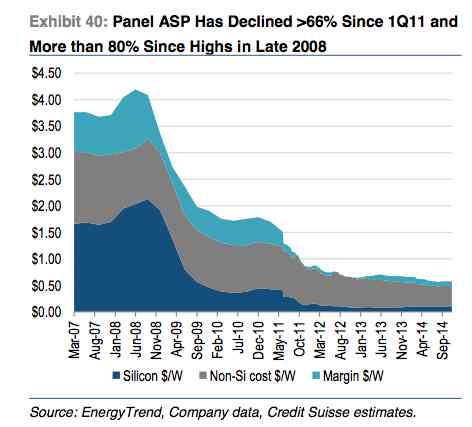1. New beaut solar technology from UNSW
PERC technology developed by UNSW is likely to become standard in more than half of all solar cell production across the globe by 2020, ushering in new dramatic falls in the cost of solar technology.
Professor Martin Green said prices in the US would likely soon fall to around $20/MWh.
- “Once you get down to those prices, very few technologies can compete,” Green said, adding that the revolution would be much quicker than most anticipated (and used some picture of the transformation in New York from the horse and buggy to the car in little more than a decade).
The following graph shows a price decline of more than 80% since 2008:

The dark blue is the cost of silicon, grey is the cost of production and light blue represents the profit margin.
2. How much does wind energy cost? Debunking the myths
Alan Moran of the Institute of Public Affairs claims that:
- increasing investment in renewables and particularly wind energy will cost consumers billions of dollars. The high operating costs and requirements for backup when the wind isn’t blowing are the problem, he argues.
Dylan McConnell, Research Fellow, Melbourne Energy Institute at University of Melbourne, examines each of his claims. McConnell finds:
- the evidence actually suggests the opposite: wind energy is already competitive with fossil fuels, will reduce electricity prices for consumers, and will play a large role in reducing Australia’s greenhouse gas emissions. (Emphasis added)
3. Abbott’s war on renewables goes north
The Canberra-based renewable energy development company Windlab is proposing a world-leading mega wind and solar project for north Queensland, a 600MW wind farm combined with a 600MW solar PV farm in what it is calling the Kennedy Energy Park near Hughenden, around 300km inland from Townsville. The estimated cost of power would be around $100/MWh.
A coal-fired generator – such as the 800MW example proposed in one recent study – would deliver power at about $130/MWh, so would require hefty subsidies from the government.
Abbott, along some local business people and local LNP politicians want to do just that, supported by loans from the new north Australia infrastructure fund.
Now here’s the rub. Windlab would need the Clean Energy Finance Corporation as a catalyst for finance for banks, “who are notoriously reluctant to stump up money for first-of-its kind facilities.”
No comment!
4. Ergon seeks 200MW of big solar, accelerates push into storage
And it is buying a fleet of hybrid cars for its own use.
- Ergon Energy, the operator of Queensland’s regional electricity network, is about to tender for up to 200MW of large-scale solar capacity, and is also looking to accelerate its push into battery storage and electric vehicles as part of its plans to transform the country’s biggest grid.
This would double large-scale solar in Australia.
Queensland is the one place in Australia that needs more power. “Shovel ready” solar projects include:
- the 1GW Solar Choice project in south-west Queensland, the 95MW Oakey project now owned by Canadian Solar, a 150MW project in north Queensland owned by FRV, and the 600MW solar project (paired with a 600MW wind project) proposed by Windlab. There are numerous other projects.
5. Queensland pushes through massive rises in fixed electricity charges
In bad news from the sunshine state, charges for electricity consumption have been reduced along with massive rises in fixed charges.
Households that consume around 7kWh a day, pensioners and single person households for instance, will now have an annual bill of more than $1,050 – which equates to a rate of 42c/kWh, probably the highest in the world.
There will be little incentive to install rooftop solar, as the saving would be negligible.
Small businesses will be hit with a “demand charge” if energy use peaks for just 30 minutes in any month.
- And to top it off, all consumers will face as-yet unspecified “metering charges”.
To me this bespeaks the culture of Energex, the operator in South-East Queensland, which is anti-renewables. The Labor Government plans to combine Energex and Ergon into one institution. Should be fun!
6. Greenland may melt faster than expected
According to new research led by Eric Rignot, fjords in West Greenland are much deeper than previously thought.
- Deeper fjords means there are “a lot more places where the warm water, subsurface water, can reach the glaciers,” Rignot said. Shallow fjords don’t pose as much of a threat.
On average, the fjords in this region are about 200 to 300 meters deeper than previously thought in some areas, he added. Glaciers undercut by warm water can melt twice as fast as those in colder waters, all other things being equal.
The implication is that sea levels will rise faster than present models indicate.

